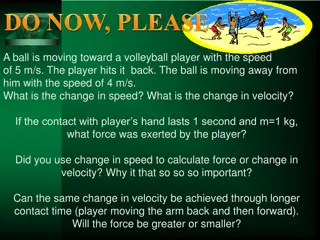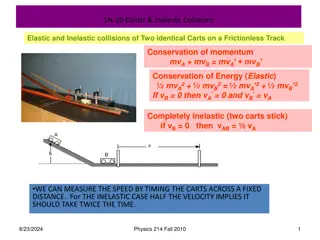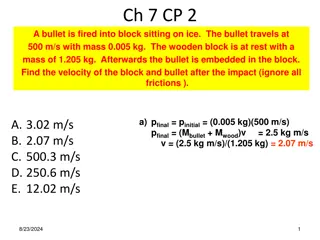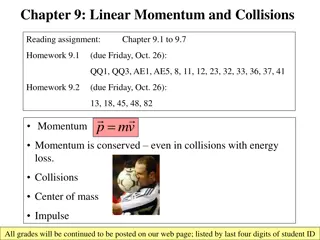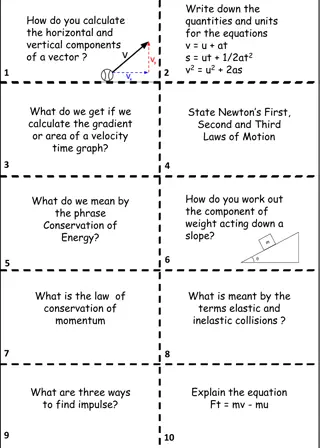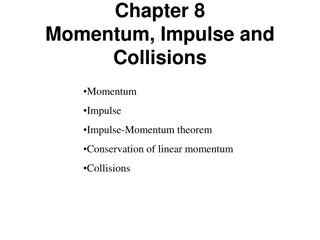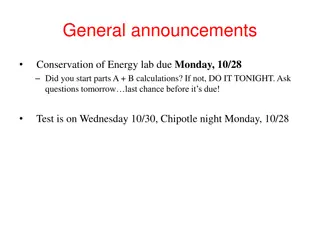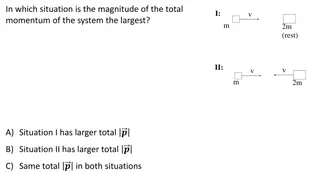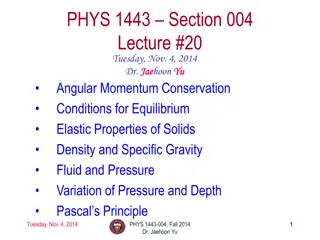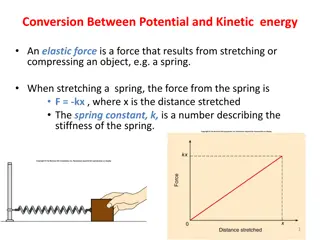Conservation of Momentum in Collisions: University of Ottawa Physics Lab
Study the conservation of linear momentum and energy in elastic and inelastic collisions in one dimension at the University of Ottawa's physics lab. Analyze the motion of gliders on an air track, observe changes in velocity, momentum, and energy, and compare position-time and velocity vs. time graphs for different collision scenarios. Explore the principles of momentum conservation within a closed system using practical experiments and data analysis.
Download Presentation

Please find below an Image/Link to download the presentation.
The content on the website is provided AS IS for your information and personal use only. It may not be sold, licensed, or shared on other websites without obtaining consent from the author. Download presentation by click this link. If you encounter any issues during the download, it is possible that the publisher has removed the file from their server.
E N D
Presentation Transcript
Conservation of Momentum 1styear physics laboratories University of Ottawa Brightspace Lab website https://uottawa.brightspace.com/d2l/home
INTRODUCTION We will study the conservation of linear momentum and energy in elastic and inelastic collisions in one dimension. A moving object possesses kinetic energy (? =1 When two objects collide in 1D, the velocity (and thus, momentum and energy) of each object changes. 2??2) and momentum (? = ??).
INTRODUCTION (cont.) We consider two gliders on the air track to be our single, closed system. The position of the centre of mass for the two gliders, ???is: ???=?1?1+?2?2 where the 1 and 2 refer to 1stand 2ndobject. In part 1 you will analyze the motion of two gliders during a collision and examine the behaviour of their centre of mass. ?1+?2
INTRODUCTION (cont.) In a closed system, any force that one object exerts on another are internal to the system. In parts 2 and 3, we will examine the momentum and kinetic energy of both gliders undergoing elastic and inelastic collisions. When two objects collide, the total momentum is conserved:
OBJECTIVES Compare position-time graphs for individual gliders with one for the centre of mass of the system. Compare velocity vs. time graphs for gliders undergoing two types of collisions. Compare momentum and kinetic energy of your system before and after the collisions.
Elastic bumpers The setup (elastic): Glider 2 (with extra masses) Glider 1
Needle and wax receptacle The setup (inelastic): Glider 2 (with extra masses) Glider 1
The setup Closer view of the elastic bumpers: Motion detectors setup: Closer view of the needle and the wax receptacle:
PRELIMINARY TASKS Launch Logger Pro, turn on air supply (note, you are sharing the supply!), adjust the air flow. Level your track using the adjustable legs. Make sure the velcro stoppers are firmly held about 10 cm from each motion detector. Make sure the round discs on both gliders are facing their respective motion detector.
PART 1 CENTRE OF MASS Download and open the LoggerPro template (from Brightspace) to help with data collection for this part. Zero both your sensors with the gliders at the centre of the track. One detector should be set to reverse direction . Enter the mass of the gliders in the user parameters . Using the elastic bumpers, gently collide glider 1 with glider 2 (at centre of track) while collecting data. Analyse the graph to determine velocities of: 1) glider 1 before the collision 2) glider 2 after the collision 3) the centre of mass before and after the collision
PART 2 ELASTIC COLLISION Using the same setup as Part 1, record data for an elastic collision (elastic bumpers). Using position vs. time graphs, obtain the velocities of each glider before and after the collision. Add a couple weights to glider 2 and try the collision again using two objects of different masses (light object hits heavier object) Try the collision again but this time have the heavier object hit the lighter one.
PART 3 INELASTIC COLLISION Switch to the needle and wax receptacle bumpers. Perform a collision with two gliders of equal mass. Make sure the gliders can travel smoothly all the way to the other end of the track without stopping after the collision. Using position vs. time graphs, obtain the velocities of each glider before and after the collision. Like in part 2, repeat for a lighter object hitting a heavier one and vice versa.
CALCULATIONS USING A SPREADSHEET Write your labels and input your data. Write the equation and press enter. If you change the data, your equation will be automatically updated. Expand your spreadsheet as required:
GRAPHS There are three graphs to create and submit for this lab. Use the Uploading graphs tool at the bottom of the experiment page in Brightspace.
CLEAN UP! Turn off the air supply, computer, and don t forget to take your USB key. Put the gliders, bumpers, and weights on the table. Please recycle scrap paper and throw away any garbage. Please leave your station as clean as you can. Push back the monitor, keyboard, and mouse. Please push your chair back under the table. Thank you! DUE DATE The report is due at the end of the lab session! Make sure you submit your graphs in Brightspace before leaving! PRE-LAB Don t forget to do your pre-lab test for the next experiment!



